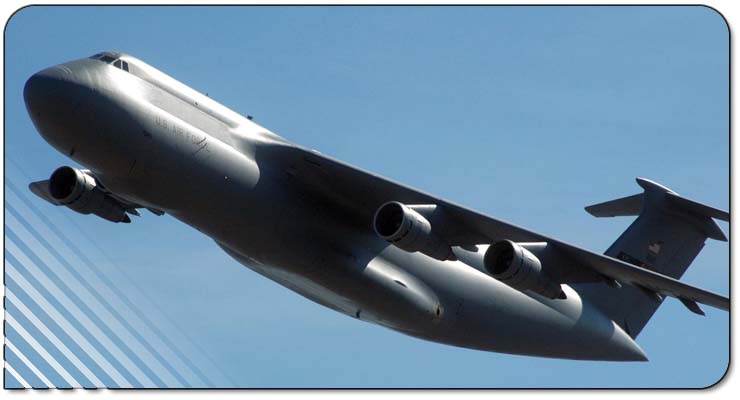Description:
The gigantic
C-5 Galaxy, with its tremendous
payload capability, provides the Air Mobility Command airlift
in
support of United States national defense. The C-5 can carry
fully
equipped combat-ready military units to any point in the world on short
notice and then provide field support required to help sustain the
fighting force.
Features
The C-5 is one of the largest aircraft in the world and the largest
airlifter in the Air Force inventory. The C-5 can carry more
than any
other airlifter. It has the ability to carry 36 standard pallets and up
to 81 troops simultaneously. The Galaxy also carries all of the Army's
air-transportable combat equipment, including such bulky items as its
74-ton mobile scissors bridge from the United States to any theater of
combat on the globe. It can also carry outsize and oversize cargo
intercontinental ranges and can take off or land in relatively short
distances. Ground crews are able to load and off-load the C-5
simultaneously at the front and rear cargo openings, reducing cargo
transfer times. Other features of the C-5 are:
- Able to operate on runways 6,000 feet long
(1,829 meters)
- Five landing gear totaling 28 wheels
to distribute the weight.
- Nose and aft doors that open the full width and
height of the cargo compartment to permit faster and easier loading.
- A
"kneeling" landing gear system that permits lowering of the parked
aircraft so the cargo floor is at truck-bed height or to facilitate
vehicle loading and unloading.
- Full width drive-on ramps at each end for
loading double rows of vehicles.
- A system that records and analyzes information
and detects malfunctions in more than 800 test points.
The C-5 has the distinctive high T-tail, 25-degree wing sweep, and four
TF39 turbofan engines mounted on pylons beneath the wings. These
engines are rated at 43,000 pounds of thrust each,
and weigh 7,900
pounds (3,555 kilograms) each. They have an
air intake diameter of
more than 8.5 feet (2.6 meters). Each engine pod is nearly 27 feet long
(8.2 meters).
The Galaxy has 12 internal wing tanks with a total capacity of 51,150
gallons (194,370 liters) of fuel -- enough to fill 6 1/2 regular size
railroad tank cars. A full fuel load weighs 332,500 pounds (150,820
kilograms). A C-5 with a cargo load of 270,000 pounds (122,472
kilograms) can fly 2,150 nautical miles, offload, and fly to a second
base 500 nautical miles away from the original destination -- all
without aerial refueling. With aerial refueling, the aircraft's range
is limited only by crew endurance.
Background
Lockheed-Georgia Co. delivered the first
operational Galaxy to
the 437th Airlift Wing, Charleston Air Force Base, S.C., in June l970.
C-5s are operated by active-duty, Reserve, and Air National Guard
crews. They are currently stationed at Dover AFB,
Del.; Travis AFB,
Calif.; Lackland AFB, Texas; Stewart Air National Guard Base, N.Y.;
Martinsburg ANGB, W.V.; Memphis ANGB, Tenn.; Wright-Patterson
AFB,
Ohio and Westover Air Reserve Base, Mass.
In March 1989, the last of 50 C-5B aircraft was added to the 76 C-5As
in the Air Force's airlift force structure. The C-5B includes all C-5A
improvements as well as more than 100 additional system modifications
to improve reliability and maintainability.
Based on a study showing 80 percent of the C-5 airframe service life
remaining, AMC began an aggressive program to modernize the C-5. The
C-5 Avionics Modernization Program began in 1998 and includes upgrading
avionics to Communications, Navigation, Surveillance/Air Traffic
Management compliance, improving navigation, communication, and safety
equipment, and installing a new autopilot system.
Another part of the modernization plan is a comprehensive Re-engining
and Reliability Program, which includes new CF-6 engines, pylons and
auxiliary power units, with upgrades to aircraft skin and frame, flight
controls, landing gear and the pressurization system. This
modernization program will enhance aircraft reliability and
maintainability, maintain structural and system integrity, reduce cost
of ownership and increase operational capability well into the 21st
century. |
WEFT Description
-
- WINGS
- ENGINE
- FUSELAGE
- TAIL
|
|

